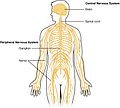Arthropod (redirect from Phylum arthropoda)
Arthropods (/ˈɑːrθrəpɒd/ ARTH-rə-pod) are invertebrates in the phylum Arthropoda. They possess an exoskeleton with a cuticle made of chitin, often mineralised...
132 KB (12,629 words) - 18:23, 17 January 2025
Daviesia arthropoda is a species of flowering plant in the family Fabaceae and is endemic to Central Australia. It is a glabrous shrub with widely spreading...
6 KB (558 words) - 20:47, 10 August 2022
List of arthropod orders (redirect from List of arthropoda orders)
segmented body, and paired jointed appendages. Arthropods form the phylum Arthropoda. They are distinguished by their jointed limbs and cuticle made of chitin...
17 KB (1,023 words) - 18:21, 3 January 2025
pairs: Hexapoda (subphylum), Arthropoda (phylum); e.g., ant 4 pairs: Arachnida (class), Chelicerata (subphylum), Arthropoda (phylum); e.g., spider 5 pairs:...
42 KB (4,104 words) - 09:29, 3 January 2025
Ecdysis (redirect from Molting (Arthropoda))
Ecdysis is the moulting of the cuticle in many invertebrates of the clade Ecdysozoa. Since the cuticle of these animals typically forms a largely inelastic...
11 KB (1,301 words) - 23:15, 18 May 2024
Abdomen (section Arthropoda)
The abdomen (colloquially called the belly, tummy, midriff, tucky, or stomach[citation needed]) is the front part of the torso between the thorax (chest)...
25 KB (2,942 words) - 18:00, 10 December 2024
Platyhelminthes, Nematoda, Annelida, Echinodermata, Mollusca and Arthropoda. Arthropoda include insects, crustaceans and arachnids. By far the largest number...
45 KB (4,980 words) - 09:43, 14 January 2025
List of genetic hybrids (section Phylum Arthropoda)
This is a list of genetic hybrids which is limited to well documented cases of animals of differing species able to create hybrid offspring which may or...
27 KB (2,815 words) - 03:16, 21 December 2024
subphylum Mandibulata constitutes one of the major subdivisions of the phylum Arthropoda, alongside Chelicerata. Mandibulates include the crustaceans, myriapods...
5 KB (289 words) - 10:18, 26 September 2024
third-largest phylum of the animal kingdom (behind only the protostomal phyla Arthropoda and Mollusca) and is also one of the most ancient taxons. Chordate fossils...
58 KB (5,270 words) - 15:28, 14 January 2025
Aestivation (section Arthropoda)
Aestivation (Latin: aestas (summer); also spelled estivation in American English) is a state of animal dormancy, similar to hibernation, although taking...
15 KB (1,604 words) - 03:36, 18 November 2024
Panarthropoda is a proposed animal clade containing the extant phyla Arthropoda, Tardigrada (water bears) and Onychophora (velvet worms). Panarthropods...
22 KB (1,816 words) - 21:16, 27 December 2024
and on land, are generally covered with a thick exoskeleton and are arthropoda and have a single pair of claws. Crab meat is the meat found within a...
12 KB (1,220 words) - 12:35, 20 November 2024
Ecdysozoa (/ˌɛkdɪsoʊˈzoʊə/) is a group of protostome animals, including Arthropoda (insects, chelicerata (including arachnids), crustaceans, and myriapods)...
27 KB (2,368 words) - 10:05, 13 January 2025
Kristensen N (ed.). Handbuch Der Zoologie / Handbook of Zoology. Vol. Arthropoda: Insecta: Lepidoptera, Moths and Butterflies. Walter de Gruyter. pp. 449–468...
66 KB (7,513 words) - 22:18, 19 January 2025
that exclude Aysheaia from the Arthropoda. It may be premature to assign Aysheaia to the Onychophora over Arthropoda, as it lacks any distinctive features...
13 KB (1,290 words) - 01:57, 13 April 2024
currently used in a narrower sense. Uniramia is one of three subphyla in the Arthropoda classification suggested by Sidnie Manton. This classification divided...
6 KB (424 words) - 00:35, 13 August 2024
indicating these two extremes. Within Animalia, the largest phylum is Arthropoda, with 151,697 ± 33,160 accepted genus names, of which 114,387 ± 27,654...
27 KB (3,131 words) - 16:41, 22 November 2024
easternmost species of Loureedia (Aranei: Eresidae) from Iran" (PDF). Arthropoda Selecta. 29 (2): 239–243. doi:10.15298/arthsel.29.2.09. Archived (PDF)...
169 KB (15,123 words) - 20:40, 14 January 2025
Kristensen, N. P.; Beutel, R. G. (eds.). Handbook of Zoology, Band 4: Arthropoda, 2: Insecta, Coleoptera, Beetles. Volume 1: Morphology and Systematics...
155 KB (16,995 words) - 02:41, 30 December 2024
Polemograptis rubristria is a species of moth of the family Tortricidae and arthropoda phylum. It is found on Peninsular Malaysia and Borneo. Wikimedia Commons...
1 KB (106 words) - 22:58, 7 December 2023
(2015). "Additional new species of Filistatidae (Aranei) from Iran". Arthropoda Selecta. 24 (4): 429–435. doi:10.15298/arthsel.24.4.05. Archived from...
107 KB (7,639 words) - 07:12, 9 January 2025
585–602. doi:10.1111/j.1096-3642.2006.00236.x. Moore, R.C. (1959). Arthropoda I – Arthropoda General Features, Proarthropoda, Euarthropoda General Features...
15 KB (1,378 words) - 17:41, 21 December 2024
record of stem groups employed in evaluating the chronogram of insects (Arthropoda: Hexapoda). Sci. Rep. 6, 38939; doi:10.1038/srep38939 (2016). Rolf G....
6 KB (382 words) - 06:02, 4 January 2025
List of troglobites (section Arthropoda)
A troglobite (or, formally, troglobiont) is an animal species, or population of a species, strictly bound to underground habitats, such as caves. These...
20 KB (1,766 words) - 05:03, 28 December 2024
Zoology. A Natural History of the phyla of the Animal Kingdom. Volume IV Arthropoda: Insecta Part 35. Walter de Gruyter. pp. 41–49. "Species Agathiphaga queenslandensis...
155 KB (16,853 words) - 18:22, 3 January 2025
Not all fauna phyla are divided into subphyla. Those that are include: Arthropoda: divided into subphyla Trilobitomorpha, Chelicerata, Myriapoda, Hexapoda...
2 KB (181 words) - 09:17, 9 October 2024
Central nervous system (section Arthropoda)
and the supraesophageal ganglia are usually seen as making up the CNS. Arthropoda, unlike vertebrates, have inhibitory motor neurons due to their small...
34 KB (3,645 words) - 16:26, 30 November 2024
Avivore (section Arthropoda)
An avivore is a specialized predator of birds, with birds making up a large proportion of its diet. Such bird-eating animals come from a range of groups...
10 KB (1,083 words) - 02:15, 3 November 2024
Handbuch der Zoologie:Eine Naturgeschichte der Stämme des Tierreiches. Arthropoda: Insecta. Walter de Gruyter. p. 1. ISBN 978-3-11-015704-8. Elias, Scott...
19 KB (1,894 words) - 00:05, 6 January 2025
























